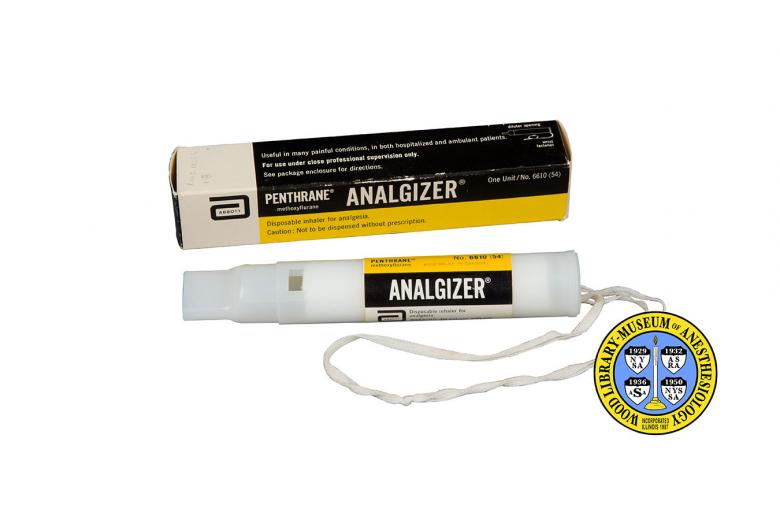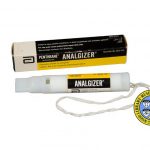Abbott Penthrane Analgizer
Self-administration inhalers allow patients to administer medications, including anesthetics, to themselves. Around 1968, Abbot Laboratories began to market their inhaler for the self-administration of the anesthetic methoxyflurane (Penthrane) for pain control during labor and short medical procedures. Abbott touted the Analgizer as simple, disposable, easy to administer and for patients to use. They emphasized the benefits of patient-controlled, self-administered analgesia, as well as the effectiveness and safety of methoxyflurane. After the liquid anesthetic was poured into the Analgizer, it was given to the patient. When the patient desired pain relief she would put the inhaler to her lips, and breathe in the anesthetic vapor. A long string loop around the patient’s wrist kept the device from falling out of reach. The Analgizer was widely used for a short time but never gained popularity.
Catalog Record: Abbott Penthrane Analgizer
Access Key: akgg
Accession No.: 2002-12-26-1 B
Title: Analgizer / Abbott.
Author: Cobb, Sanford.
Author: Katerndahl, Dean Richard.
Author: Murphy, William Emmett.
Corporate Author: Abbott Laboratories.
Title variation: Alt Title
Title: Abbott analgizer.
Title variation: Alt Title
Title: Analgizer : penthrane.
Publisher: Chicago, Illinois : Abbott Laboratories, [1967-1975].
Physical Descript: 1 inhaler : plastics, fabric ; 3 x 15.5 cm.
Subject: Anesthesia, Inhalation – instrumentation.
Subject: Inhalers, Anesthesia.
Subject: Methoxyflurane.
Subject: Anesthesia, Obstetrical.
Subject: Analgesia – methods.
Subject: Analgesia, Obstetrical.
Note Type: General
Notes: Broad dates based on the dates of publications in which the Analgizer is
mentioned in. One source, “Pharmacology for Anesthetists: Anesthetics and
Adjuvants,” edited by John D. Current (date of publication unknown) suggested
that he Analgizer was on the market from 1968 to 1974. The WLM library does
not have access to this publication, only a ‘snippet’ view via Google Books,
and so these dates were not confirmed.
Note Type: With
Notes: The original cardboard container (box); The primary colors on the box are
yellow, white and black; The box measures 3 x 16 x 3 cm.; Markings on the
‘front’ include the Abbott logo, and the following text, “PENTHRANE”; Below
the word “penthrane” is small text is “methoxyflurane”; To the right of these
is, “ANALGIZER”; Also printed on the front is small lettering is, “One
Unit/No. 6610 (54)”, “Disposable inhaler for analgesia.” and “Caution: not to
be dispensed without prescription.”; Text printed on the three sides includes
but is not limited to, “Lightweight, portable, versatile, convenient,
economical, disposable.”, “Lot No.” D846 464″, “Do not store for prolonged
periods at extreme temperatures.”, “WARNING: DO NOT USE WITH ANY AGENT OTHER
THAN PENTHRANE. FOR USE BY ONE PATIENT ONLY.”, “Made in U.S.A.”, “ASSEMBLED
IN CANADA”; Abbott Laboratories, North Chicago, Illinois 60064, U.S.A.”Useful
in many painful conditions, in both hospitalized and ambulant patients.”,
“For use under close professional supervision only.”, “See package enclosure
for directions.”; On each end of the box is printed, “PENTHRANE
methoxyflurane ANALGIZER disposable inhaler for analgesia.”
Note Type: Citation
Notes: Analgizer: An Alphabet of Analgesia. North Chicago, Illinois: Abbott
Laboratories; 1968:1-15.
Note Type: Citation
Notes: Artusio JF Jr, Van Poznak A, Hunt RE, Tiers RM, Alexander M. A clinical
evaluation of methoxyflurane in man. Anesthesiology. 1960;21(5):512-517.
Note Type: Citation
Notes: Buntine P, Thom O, Babl F, Bailey M, Bernard S. Prehospital analgesia in
adults using inhaled methoxyflurane. Emerg Med Australas. 2007;19(6):509-514.
Note Type: Citation
Notes: Cobb S, Katerndahl DR, Murphy WE. Self-regulating therapeutic inhaler. US
patent 3,565,071. February 23, 1971.
Note Type: Citation
Notes: Hatano S, Sadove MS, Shulman M, Redlin TA, Callegari EG, Yoo HJ. Study of a
new inhaler (Penhalor) for obstetrical analgesia. Can Anaesth Soc J. 1971
Jul;18(4):454-464
Note Type: Citation
Notes: Marx GF, Chen LK, Tabora JA. Experiences with a disposable inhaler for
methoxyflurane analgesia during labour: clinical and biochemical results. Can
Anaesth Soc J. 1969;16(1):66-71.
Note Type: Citation
Notes: Mazze RI. Methoxyflurane revisited: tale of an anesthetic from cradle to
grave. Anesthesiology. 2006;105(4):843-846.
Note Type: Citation
Notes: Mazze RI, Trudell JR, Cousins MJ. Anesthesiology. Methoxyflurane metabolism
and renal dysfunction: clinical correlation in man. 1971;35(3):247-252.
Note Type: Citation
Notes: Methoxyflurane (Penthrox) for analgesia. NPS RADAR. NPS Medicinewise website.
https://www.nps.org.
au/publications/health-professional/nps-radar/2010/may-2010/methoxyflurane.
Published November 10, 2010. February 27, 2013.
Note Type: Physical Description
Notes: 1 plastic inhaler; Cylindrical body approximately 15.5 cm in length and 2.6
cm in diameter; A mouthpiece is on the proximal end; The distal end is
indented, with openings around the internal diameter for liquid anesthestic
to be poured into the inhaler and onto the wick; A white, yellow and black
label is applied around the inhaler; Text on the label includes, “PENTHRANE
[new line methoxyflurane”, “No. 6610 (54)”, “ASSEMBLED IN CANADA”,
“ANALGIZER”, the Abbott logo, “Disposable inhaler for analgesia.”, “WARNING:
Do not use with any agent other than PENTHRANE.”, “For use under close
professional supervision only.”, “Caution: Not to be dispensed without
prescription.”, “For use by one patient only.”, See package enclosure for
directions.”, “Lot No. D846 464”, “Made in U.S.A. [new line] 07-6024–2/F1”,
“Abbott Laboratories [new line] North Chicago, Ill. 60064, U.S.A.”; A narrow
gauze like wrist band is attached to a small eyelet on the distal end of the
inhaler.
Note Type: Reproduction
Notes: Photographed by Mr. Steve Donisch on January 14, 2013.
Note Type: Historical
Notes: Around 1968, Abbot Laboratories began to market their inhaler for the
self-administration of the anesthetic methoxyflurane (Penthrane) for pain
control during labor and short medical procedures. Abbott touted the
Analgizer as simple, disposable, easy to administer and easy to use. They
emphasized the benefits of patient-controlled, self-administered analgesia,
as well as the effectiveness and safety of methoxyflurane. After the liquid
anesthetic was poured into the Analgizer, it was given to the patient. When
the patient desired pain relief she would put the inhaler to her lips, and
breathe in the anesthetic vapor. A long string loop around the patient’s
wrist kept the device from falling out of reach. The Analgizer was widely
used for a short time but never gained popularity.
Note Type: Historical
Notes: In 1960 Dr. Joseph F. Artusio, Jr. and Dr. Alan Van Poznak published a report
on their team’s successful experience using methoxyflurane for inhalation
anesthesia in 100 patients. A number of other positive reports quickly
followed and it seemed that methoxyflurane was a perfect anesthetic:
nonexplosive and nonflammable with fast induction and recovery times and few
adverse effects. In 1971, Drs. Richard I. Mazze, James R. Trudell and Michael
J. Cousins published evidence that methoxyflurane could adversely affect
kidney function. Their research confirmed the results of an earlier study and
by the late 1970s methoxyflurane fell out of use in the United States.
However, it continues to be used successfully as a short-term sedative and analgesic in
Australia and New Zealand.
Note Type: Publication
Notes: Goldstein IC, Dragon AI, Cobb S. Inhalation analgesia by nasal cannual and
nasal hood; an anternative to Narcotics? Anesth Prog. 1968;15(10):289-291.
Note Type: Publication
Notes: Van Poznak A. Methoxyflurane (Penthrane): seeking its niche. In: Dobkin AB,
ed. Development of New Volatile Inhalation Anaesthetics. Amsterdam: Elsevier;
1979:313.
Note Type: Exhibition
Notes: Chosen for the WLM website (noted February 26, 2013).


